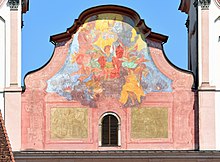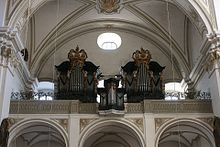Parish Church Steyr-St. Michael
The parish church of Steyr-St. Michael is in the district of Steyrdorf in the municipality of Steyr in Upper Austria . The Roman Catholic parish church of St. Michael belongs to the Deanery of Steyr in the Diocese of Linz . The church is a listed building . The former Jesuit church shapes the townscape of Steyr with its elevated location at the confluence of the Steyr and Enns .
historical overview
The victory over the Turks invading from the east gave the architecture new impulses - the baroque style became an expression of the great renewal of cultural and ecclesiastical life. The Catholic restoration was another indicator of the exuberant renewal phase in the Steyr church landscape.
In the period from 1635 to 1681 , three baroque monastery complexes were built in Steyr, which was previously the center of the Protestant community: the Michaelerkirche, the Dominikanerkirche and the church of the Cölestinerinnen . In 1551 the Roman-German King and later Emperor Ferdinand I brought Jesuits to Austria . The order opened grammar schools and Latin schools in larger cities, as it regarded the education of young people as an essential task in addition to pastoral care. The order received active support in Steyr from Burgrave Siegismund von Lamberg and Abbot Anton Spindler from Garsten . A Jesuit residence was established.
In 1630 Emperor Ferdinand II commissioned the city of Steyr to leave eleven houses near the Citizens' Hospital to the Jesuits to build a church with a college. In 1632 the order took over the objects and started school lessons. In 1634 the demolition of the houses and preparations for the construction of a new church began. In 1648 the church was consecrated by the Passau Auxiliary Bishop Ulrich Grappler von Trappenburg . In 1677 the construction of the two towers was completed. As soon as the church was completed, construction of a six-class high school began in 1678. After two years of construction, lessons could begin in the new school. The towers of the Michaelerkirche were raised from 1766 to 1770 and Franz Xaver Gürtler , the artist of the high altar painting, also painted the gable with an angel's lintel. The church existed as a college church until the abolition of the Jesuit order in 1773. Until 1785 there was only one parish in Steyr, St. Aegid and Koloman - today's parish church . With his reforms of the church organization, Emperor Joseph II achieved an intensification of pastoral care. The orphaned church of the Jesuits offered itself as the second parish church of Steyr. In 1785 the suburban parish with the church of St. Michael the Archangel was built . In order to get a parsonage, the opposite Gothic hospital church was profaned and converted into a residential and parsonage. For the parish jubilee, the church was fundamentally renovated between 1877 and 1885. This renovation had to be corrected in 1989 and adapted to today's requirements of monument preservation.
Building description
The building typology of Steyr's Michaelerkirche shows parallels to the Jesuit Church in Munich . In the Jesuit Church of St. Michael in Munich, the building type of the wall pillar church can be found for the first time , in which a nave with attached chapel niches represents the main architectural motif. This type of building dominated the whole of southern Germany in the second half of the 17th century. The church in Steyr has a single-nave, four-bay north-south-facing nave with lancet barrel vaults on belts. In the southern yoke is the three-axis organ gallery on a groin vault. Barrel-vaulted side chapels are arranged in the three adjoining bays. On all galleries, richly designed wrought iron spiral grids from the last quarter of the 17th century form the end of the nave above the side chapels. Stucco decorations with palmettes, pearl and egg bars and angel heads can be seen on all the vaults of the church. This stucco was painted over several times during previous restorations. The last major restoration of the church took place in 1989, during which the original room setting was restored, and frescoes from the construction period with depictions of the four archangels ( Michael , Gabriel , Raphael , Uriel ) were uncovered. The Ionic colossal pilaster order is characteristic of the church interior.
The mighty church building stands on an elevation above the bridgehead and dominates the townscape of the Steyrdorf. The three-storey, two-tower facade has a monumental entrance portal, dated 1677, with the inscription HIC DEUM ADORA ( Latin here worship God), above it stands a statue of the Mother of God with the baby Jesus in a niche, flanked by statues of the apostles Peter and Paul. At the top of the portal, the coat of arms of Prince Eggenberg is incorporated.
A larger chapel dedicated to St. Francis Xavier is built on the left side of the church .
Furnishing
Most of the furnishings date from 1763 to 1771. The interior is characterized by the late Baroque and Classicism.
The mighty high altar, which takes up the entire choir, dates from 1766/67 and its structure has a classical influence. In 1769, the Steyr-based master Franz Xaver Gürtler painted the altarpiece with the depiction of the Archangel Michael as the victor over Lucifer. The mighty statues represent the holy archangel Raphael with Tobias on the right side , the holy guardian angel on the left . The tabernacle on the main altar was designed by Richard Jordan .
The pulpit and the organ are among the most valuable furnishings in the parish church. The pulpit, manufactured around 1770, is a foundation of the Steyr-based royal family Lamberg , whose coat of arms adorns the sound cover. A statue of the good shepherd forms the upper end . The cheeks of the pews show an impressive carving.
The organ comes from the Garstner Stiftskirche and is an early work by Johann Ignaz Egedacher . It was created in 1707 and was transferred to the Michaelerkirche in the course of the Josephine reforms. The renovation and expansion took place in 1780 by Franz Xaver Krisman . The instrument has 27 stops on two manual works and a pedal . The playing and stop actions are mechanical.
|
|
|
||||||||||||||||||||||||||||||||||||||||||||||||||||||||||||||||||||||||||||||||||||||||||
- Coupling : II / I, I / P, II / P
Urban classification
The Michaelerkirche stands dominantly elevated on a platform at the intersection of the Kirchengasse - Schlüsselhofgasse - Steyrbrücke, the main traffic routes to Wels and Linz on the one hand and to Enns on the other until the 1950s. Its towers come from the town square, at the beginning of the Engen Gasse, a landmark that signaled the presence of a strict church representation to the citizens in the old town during the Counter-Reformation. The church complex appears like a fortress with the massive structure of the attached grammar school on the ascent to Tabor and gate-like to the beginning of Kirchengasse. The valuable and significant architectural effect can also be seen in the interplay with the Bürgerspitalkirche and the compact building of the Bürgerspital, the effect of which is exaggerated in the reflection in the Steyr River.
literature
- Steyr, Michaelskirche. Pp. 330-331. In: The art monuments of Austria. Dehio Upper Austria. By Erwin Hainisch , reworked by Kurt Woisetschläger , prefaces to the 3rd edition (1958) and 4th edition (1960) by Walter Frodl , sixth edition, Verlag Anton Schroll & Co., Vienna 1977.
- Josef Ofner : Art Chronicle of the City of Steyr. In: Publications of the cultural office of the city of Steyr. Issue 30, 1972.
- Adolf Bodingbauer: Steyr, St. Michael , Peda-Kunstführer, Passau 1992.
Individual evidence
- ↑ a b Buildings: Vorstadtpfarre St. Michael (steyr.at) accessed on November 5, 2012
- ↑ cf. Bernhard Peter: St. Michael in Steyr (Michaelerkirche) with a detailed description of the coat of arms relief
- ↑ Information on the organ
Web links
Coordinates: 48 ° 2 ′ 37 ″ N , 14 ° 25 ′ 17 ″ E









